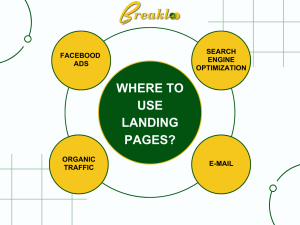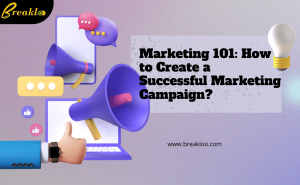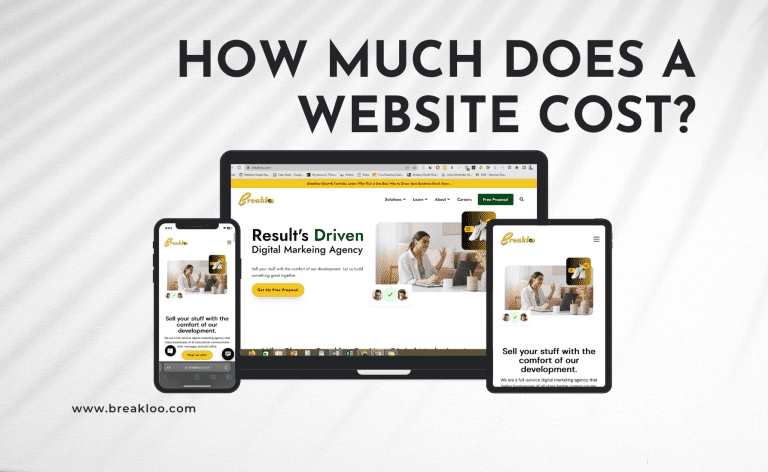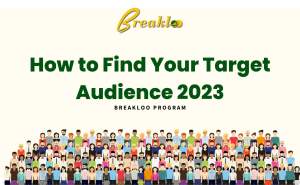What Are Landing Pages?
Landing pages are specific pages or websites that have been created for single goal-oriented purposes.
Landing pages are designed to increase conversions in online advertisements.
Customers are directed to the landing page from various online campaigns: online advertisements, email marketing, and many other sources.
Landing Page vs. Homepages and Websites
The main difference between landing pages and homepages is that the landing pages have only a single goal.
Regular websites try to provide as much information about the whole website, all the products it sells, and any additional information.
Landing pages usually include only one CTA (Call-to-Action) to promote a single conversion.
For example, these conversions could be:
- General contact
- Product
- Lead collections
- Showcases
- Etc.
A traditional online store’s homepage would display a lot of its products or categories. Landing pages try to limit all the possible distractions to make their single goal happen.
An online store utilizing landing pages would create the landing pages around the products it wishes to advertise more.
For example, the online store would be advertising new categories and products to have a more clear insight into how the new products are getting engagement from their customers.
Including the above, there are many benefits to using landing pages in online advertising.
Where and Why Landing Pages Are Used
Companies that use landing pages increase their result rates in their marketing strategy.
Landing pages directly increase conversion rates, therefore, boosting the profitability of a marketing campaign.
The best situations for using them are when you have total control of the links used in an advertisement.
Four traffic source examples for landing page use:

Search Engine Marketing (SEM)
Landing pages in Google Ads helps to target keywords more efficiently.
In the best-case scenario, you would have a landing page per ad group that wouldn’t have many keywords used in the first place.
When the ads, keywords, and landing pages are matching it optimizes Google Ads. In return, it would increase the ad ranks and scores, which lead to a lowered advertisement cost in the end.
Facebook Advertising
The landing page in Facebook Advertising allows us to create highly targeted pages for every campaign and ad group. We recommend producing a different page for every possible ad group and very least for every campaign to maximize results.
In the beginning, it’s harder to optimize the content of the pages, but as data starts flowing in, the data will tell us what kind of content works the best for every campaign and ad group.
As the campaigns progress towards its goals, Facebook will have more data and show ads to those who are likely to convert.
Email Campaigns
Email campaigns and landing pages are made for each other. Unique email campaigns with unique pages increase results across the campaigns.
For example, you could create a specific landing page for all of the different email lists you have available. It will keep the subscribers more engaged as the content fits the page and likely to click and visit the page.
Organic Traffic
Landing page SEO and achieving organic traffic for landing pages can be difficult because of the nature of the pages. Landing pages should be using the best SEO techniques, however.
For long-term campaigns (6 months and up), SEO becomes vital as any generated traffic could potentially be valuable for a website and business. Not using the techniques will be a waste of resources as it would be simple to implement SEO while creating the pages in the first place. SEO could lower the cost of the planned marketing campaigns overall.
Landing pages and its content could be tested first with paid traffic, and when data of the campaigns become available, start implementing data to the landing page itself and for the whole website.
7 Tips For How To Create Landing Pages
We have seen by creating multiple converting sites a couple of guidelines on how to make landing pages convert better for ourselves and to our clients.
1. Decide on Goals
The most important part of creating the landing page is deciding why do we want to create one. Every goal requires a different style of the page. Do you want to increase sales of a certain product, collect leads, or increase email subscribers?
2. Think About Your Target Audience
Every target audience acts and reacts differently to diverse styles of communication and content. It’s necessary to find the most suitable approach every time.
The benefit of using landing pages is the possibility to create multiple versions with distinctive differences.
A/B testing and its data show us what kind of content has worked the best for different target audiences. Choose the best-performing pages and keep optimizing, until campaign goals are met.
3. Copywriting and Content
To obtain the best results, produce text and images that are thoroughly examined, match branding, and fits the audience.
- Titles
- A title should always be enticing for the readers that would make them stay longer and eventually convert.
- Body
- The content should be informative, precise, and to the point.
- For example, a discount campaign in an online store: Communicate and precisely inform what products on the page are on sale. In an email list campaign, it’s important to tell the reason why you would be collecting their emails.
- Call to Action – CTA
- Keep the CTA, and it’s goal clear. Never create confusing or misleading CTA’s.
- Footer
- Keep the business and website information in the footer. Your customer will appreciate the honesty, and it will build trust when they understand with whom they are conducting business.
- Images and Videos
- Take advantage of beautiful and effective images and videos. Take your brand, goals, and audience into consideration.
Read more about content marketing in general.
A Landing page example:

For more examples, check Hubspot’s list of 19 landing pages for 2020.
4. Product and Service-Based Landing Pages
Describe your product and services, as well as you can, on the pages. The difference to the regular product pages is that you can describe your product from another point of view that serves your various customer bases accordingly.
By using landing pages, you won’t have to create multiple product pages from the same product.
Utilize good storytelling always when it’s possible.
5. Make use of customer feedback and reviews
If possible, use reviews, feedback, and customer recommendations on the page. Reviews raise trust in your business greatly and to its services.
Reviews and recommendations lower the barrier of purchase and its a beautiful method to increase conversion rates.
6. Use discounts
Always it’s not possible to create discounts for every campaign. However, when it’s possible, it will increase the results of the campaigns.
When marketing products and services, discounts should be tested at the very least. Also, try different discounts, upsells, and other combinations to find the most suitable. You might be happy to know that offering the lowest discount might not be the best conversion-wise.
7. Share the page
Use every online marketing method possible to launch the pages to the world. Analyze the opportunity of using online advertisements, email, social media, and any other method of growth marketing.
Landing Page Analytics
Landing pages are tracked with the use of web analytics. The key is to use correct metrics for every purpose. Using relevant metrics, we can see potential problems early on and see how much is our page has produced results.
Use at least Google Analytics, when tracking the performance of landing pages. Utilize data sources your landing page provider might have.
Tracking at least these following six metrics below will bring more results.
Conversion Rates
The most important metric in landing pages is overwhelmingly conversion rates.
Does your page convert the way it was designed or at all?
An average conversion rate would be from 2.35% and up. When analyzing data from landing pages, 2.35% should be your first reference point.
Conversion rates, of course, depend on the nature of the business, its goals, and the industry.
A quarter of websites can achieve a conversion rate of 5.31%, and the top 10% reaches up to 11.45% or higher, according to Wordstream.
Page Views, Pages/Session
Track the number of page views your page has received at a certain time.
Combine the data with the results of your online advertising platforms like Google Ads or Facebook. You will see if the data matches the user quantities and how many pages they have checked during their visit.
You might be able to see if they dropped before they’ve reached your website.
Average Session Duration
Depending on your goals session duration, it might be a critical metric to track.
Websites that are trying to enact customers to keep reading their website after the landing page experience, tracking sessions duration would be crucial.
Websites that use landing pages for single-purposes might not need to track duration actively. Make sure the session duration is still longer than it takes you to read through your page. Otherwise, the intent of the content might not come through.
Bounce Rates
The bounce rate means the percentage of users who land on the site without continuing to other pages. Depending on the structure of your page, this will be important.
If your conversions all happens on the same page, bounce rates will not tell the whole truth for the page.
The bounce rate tells the website that the landing page hasn’t matched with the source of traffic, and the user has left because of it. A high bounce rate might also tell us about technical aspects of the website not being perfect, like loading speeds.
Tracking Behavior
Track on-page behavior with tools such as Hotjar, to understand how your users have reacted to certain website elements.
Do they behave in an intended way, or they distracted by some unforetold way?
A/B Testing Landing Pages
A/B means testing and analyzing two versions of the same page.
With constant testing, we can achieve better results, more sales, more engagement, and a better understanding of our target audiences.
What Should I Test And Then Optimize In A Given Page?
Before any testing can happen, there is a couple of things to keep in mind.
Define the first versions, and to this, we compare all other versions. You must also define the time range in question. When these two things are clearly defined from the beginning, it lowers the chances of making mistakes.
Don’t let false data cloud your judgment of your goals. Always keep looking for opportunities that analyzing data might discover for you, though. You can create new tests as data comes in with new ideas.
Stop the test after the initial time has passed. Analyze all the data carefully you have received. Keep the winning versions alive and create new tests against them.
Sometimes the results will be hard to decipher, or there’s an element of surprise when analyzing the results. It’s up to you to make data-based decisions to find the best variations.
At least A/B Test With the Following:
Offering
By frequently changing and testing different offerings, you will discover what your target audience wants. For example, a long text-based product description wouldn’t work as well as a short informational video for making more sales.
Only test with a single offering per page and follow the data, and how does it affect the whole picture.
Another example that online stores can use is testing different discount codes when they join an email list.
Landing Page Design
The design of a page can be a crucial aspect of how a certain page converts.
Even the smallest changes like changing, the positions of text or highlighting images can have drastic effects on the page.
One method to test is how do lengths of the text impact conversions.
Titles and Body
Different titles should be tested to see which one is the best for the landing page.
Try completely distinct combinations of words to see which resonates the best with your audiences. Use previous Google Ads data, if possible, to discover the best title and description combinations that have worked the best.
Start with optimizing titles first, and when you have reached a positive result, you can start optimizing the body text, as well.
Always test titles with titles and body text with other body text. Don’t take a lot of variations into tests as it only makes it harder to analyze.
Optimize Call To Action
A call to action is what makes users convert on the page. Testing several of CTA’s separately to various offerings can make a big impact on results.
You can mix a set of fonts, copy, placement, and colors.
Product and Service Descriptions
If the landing page is all about selling products or services, then you have to test how would different descriptions work.
Like we discussed with titles, always test one variation at a time.
Video and Images
When images and videos are used on the page, you should be testing them as well. Concretely look for how the videos or images impact the conversions if at all.
If images and videos aren’t relevant on the page, don’t try to optimize them until you have found success in other metrics.
Whatever you’re testing, remember to learn from the data as its the only way to increase results you want. Use the data to improve the rest of your website as well.
Breakloo “digital marketing agency” helps companies discover their best digital marketing strategy, increasing sales online and increasing visibility, whether with the use of landing pages, or online advertisements.
Top trending articles “digital marketing agency”:
“cost per lead formula” Click here – Cost Per Lead Formula With Example
“website vs web application” Click here – Website Vs Web Applications
how to “rank higher on google” Click here – How to Rank Higher on Google
“digital marketing agency” Click here – Digital Marketing Agency
“best website development company” Click here – Best Website Development Company
“ecommerce website development company” Click here – eCommerce Website Development Company
“advanced digital marketing” Click here – Advanced Digital Marketing Article+PDF’s



